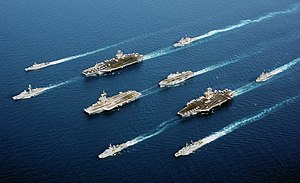Fleet (navy)
The term fleet refers to a larger number of ships. It is used for merchant and warships .
Civil fleets
For Germany, Article 27 of the Basic Law provides : "All German merchant ships form a single merchant fleet." In some other countries, a distinction is made between the actual merchant fleet , a research fleet and a fishing fleet .
Also in the passagierbefördernden (also known as maritime passenger ships or passenger ships referred to) is a set of passenger ships , cruise ships , ferries , etc. sometimes as fleet referred, for example, the White Fleet .
Military fleets

In military parlance, the term fleet can be defined differently:
- General term for the navy of a state,
- Main part of the active combat units of a Navy (most common use),
- Large association within a navy;
- Occasionally large units of the air force were referred to as air fleets.
Fleets can be further divided into flotillas or squadrons . You will be guided ashore by either a flagship or a headquarters .
Fleets in Germany
In the various phases of German naval history , the term fleet was usually understood to mean the combination of large combat units such as ships of the line or battleships that were to be used together in combat. Smaller units were usually not subordinate to the fleet, but to regional naval commanders. In the Imperial Navy , most ships were initially deactivated in winter, and a training fleet was only set up in the summer of each year. It was not until the beginning of the 20th century that a permanent fleet came into being with the deep sea fleet. In the Reichsmarine and the Kriegsmarine there was a fleet chief to whom the large ships were subordinated for the respective use.
In the German navy , the combat and support units, most of the Navy in the fleet were summarized by the commander of the fleet in Fleet Command was performed. With the realignment of the Bundeswehr on October 1, 2012, the higher command authorities were combined in the naval command, which has taken on the essential tasks of the fleet command. The term “fleet” has therefore been dropped.
In the meantime, the Deputy Inspector of the Navy was given the title of Commander of the Fleet and Support Forces, so that there is now a Commander of the Fleet in the naval command.
Fleets in the USA
The US Navy distinguishes between administrative and operational fleets. The administrative fleets are the Atlantic fleet and the Pacific fleet , the operational fleets are assigned to sea areas. These are the:
- United States Second Fleet - US East Coast and North Atlantic , fleet disbanded in 2011 and re-established in 2018 as tensions with Russia increased
- United States Third Fleet - Eastern and Northern Pacific, including the Bering Sea, Alaska, the Aleutian Islands and a sector of the Arctic Ocean , a total of five million square kilometers of sea area.
- United States Fourth Fleet - Caribbean Sea, as well as the Pacific and Atlantic off South and Central America
- United States Fifth Fleet - Persian Gulf, Red Sea, Arabian Sea and parts of the Indian Ocean .
- United States Sixth Fleet - Mediterranean and Eastern Atlantic
- United States Seventh Fleet - Pacific
- United States Fleet Cyber Command / United States Tenth Fleet - US Navy Cyber Command , leads all US Navy cyber forces worldwide.
Soviet and Russian fleets
The division into four fleets goes back to the Imperial Russian Navy and was adopted in the Soviet Navy and the Russian Navy :
Web links
Individual evidence
- ↑ Axel Schimpf. The naval command in Rostock - the navy on course for the future . In: Marineforum 1 / 2-2013, p. 22ff.
- ^ Official website of the Navy , accessed June 11, 2019
- ↑ Homepage US Fleet Cyber Command / US Tenth Fleet , accessed June 11, 2019